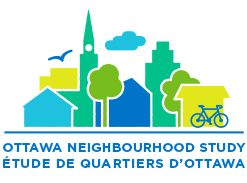Welcome to Ottawa Neighbourhood Study
The Ottawa Neighbourhood Study (ONS) provides data on strengths and challenges for each neighbourhood in Ottawa. By all working together we can improve the neighbourhoods in which we live. Click on the map to identify a neighbourhood about which you would like to find more information.
Evidence is mounting that the neighbourhoods and communities in which we live affect not only our health but also the gap in health between rich and poor. The purpose of the Ottawa Neighbourhood Study (ONS) is twofold: to better understand the physical and social pathways by which neighbourhoods in Ottawa affect our health and well-being, and to provide citizens in Ottawa with facts that support evidence-based decision-making.
ONS is committed to publicly available and accessible data. Please give ONS credit for each use or reproduction of these data sets and other information found here. For more information, see our Terms of Use.
ONS is based at the Centre for Research on Educational and Community Services (CRECS) at the University of Ottawa. A multidisciplinary study, ONS is grateful for funding support received from the Canadian Institutes of Health Research (CIHR), United Way East Ontario/Centraide de l’Est de l’Ontario, the Ottawa Community Foundation, the Population Health Improvement Network (PHIRN), and Champlain LHIN. ONS is a member of the Ottawa and Region Data Consortium hosted by the Social Planning Council of Ottawa as a component of the Community Data Program of the Canadian Community Economic Development Network. This website was made possible thanks to a IBM Smarter Planet grant and the valuable contributions of volunteers at the IBM i2 Ottawa office.
We hope that municipalities, community organizations, health and social service agencies, and concerned citizens will use this knowledge for evidence-based community planning. ONS is a stepping stone to coordinate efforts that can have a greater impact and to improve the places in which we all live, work and play.
[/su_column]
Watch the videos below to learn about social inequities in the COVID-19 Pandemic and how ONS data is being used to understand these inequities:
